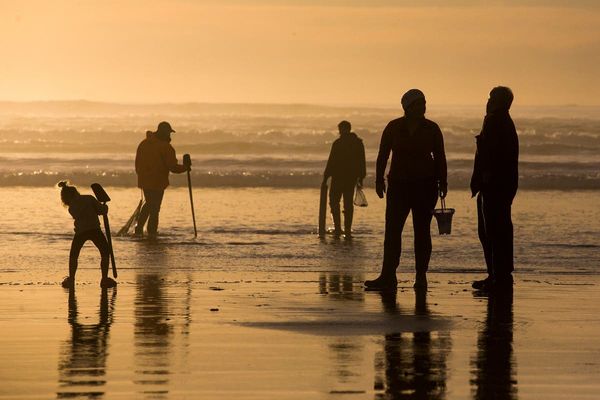
So distinctive was the soaring, heart-piercing sound of David Sanborn’s alto saxophone, and yet so comprehensive in its instant evocation of the spirit of a certain essence of US popular music, that it became familiar to many millions who knew nothing of the jazz world from which it had emerged.
Sanborn, who has died aged 78, penetrated the broader consciousness when called on to add his musical signature to David Bowie’s Young Americans in 1974, and later found success with his own funk-influenced instrumental albums, including Voyeur, Straight to the Heart and Double Vision.
In his days as a session musician he contributed to Stevie Wonder’s Talking Book and Bruce Springsteen’s Born to Run. Among the countless other stars with whom he recorded were Aretha Franklin, Sting, the Eagles, Rickie Lee Jones, James Brown, George Benson, Carly Simon, Elton John, Bryan Ferry and the Rolling Stones. With Eric Clapton, he was featured on the soundtrack of the film Lethal Weapon and its several sequels.
Although he learned his trade among jazz musicians, Sanborn was soon spreading his wings. In 1969 he appeared at the Woodstock festival with the Paul Butterfield Blues Band, filling the breakfast slot on the final day between Crosby, Stills, Nash and Young and Sha Na Na. Eventually he became identified with the jazz-funk movement and then, unfairly, with its debased successor, the radio-friendly genre of background music known as smooth jazz.
Familiar to the US television audience in the 1980s through his appearances with the house bands on Saturday Night Live and Late Night with David Letterman, he also co-hosted, with Jools Holland, a series called Night Music, whose guests ranged from Fontella Bass and Lyle Lovett to Miles Davis and Sonny Rollins.
Born in the city of Tampa, Florida, Sanborn was brought up in Kirkwood, Missouri, a suburb of St Louis. At the age of three, he suffered polio damage to his lungs and his left arm and leg. At 11, having already begun studying the piano, he was advised by a doctor to switch to a wind instrument to improve his breathing.
His parents loved jazz, and soon he was falling heavily under the spell of Hank Crawford, the featured alto saxophonist with the band of the singer Ray Charles, a player whose work combined the elements of jazz, blues and gospel music. By his mid-teens he was visiting St Louis nightclubs to sit in with such visiting R&B artists as Albert King and Little Milton and playing with a trio including the Hammond organist Don James, a disciple of Jimmy Smith.
He studied music first at Northwestern University in Evanston, Illinois, and then at the University of Iowa. One summer in the early 60s he also attended the National Stage band camp in Indiana, where he met other promising teenagers, including the pianist Keith Jarrett, the vibraphonist Gary Burton and the trumpeter Randy Brecker.
Back home in St Louis, he spent time with the trumpeter Lester Bowie, the drummer Phillip Wilson and the saxophonists Julius Hemphill, Oliver Lake and Hamiet Bluiett, adventurous local jazz musicians who would go on to establish themselves as leading figures in the avant garde of a later generation. It was through Wilson that in 1967 he joined Paul Butterfield, with whom he made his recording debut on an album titled The Resurrection of Pigboy Crabshaw.
Arriving in New York at the start of the 70s, he joined Randy Brecker and his brother Mike, the tenor saxophonist, in a horn section that was soon much in demand for recording sessions with younger artists. He was a member of Wonder’s touring band (1971-73) before joining David Bowie for the 1974 tour to promote the release of Diamond Dogs and to perform songs from the forthcoming Young Americans – on which, he said, he took the role normally occupied by a lead guitar.
Many jazz fans were also becoming aware of him through his prominent role in the Gil Evans orchestra, with which he was featured on Evans’s recasting of Jimi Hendrix’s Angel, performed during a memorable concert at the Royal Festival Hall in London in 1978.
A friendship with the bass guitarist and producer Marcus Miller intensified the influence of funk on Sanborn’s music. Together with the guitarist Hiram Bullock and the drummer Omar Hakim, Sanborn and Miller constituted the resident band of Night Music between 1988 and 1990.
When his solo recordings took flight, after finding favour with disc-jockeys on jazz radio stations, Sanborn toured extensively under his own name, playing clubs and festivals around the world.
His commercial success could be measured in his six Grammy awards, one platinum album (Double Vision, co-led with the pianist Bob James in 1986) and eight gold albums.
He was certainly not unfamiliar with accusations that here was yet another white populariser enjoying the sort of material rewards denied to Black innovators. But he cherished his links with his origins, continuing to collaborate with musicians from the jazz world, including the vibraphonist Bobby Hutcherson, the bassist Charlie Haden and the organist Joey DeFrancesco.
When challenged on his authenticity as a jazz musician, Sanborn responded that his music came from R&B and gospel as well as jazz. “It wasn’t any one of those things but it was all of them kind of mixed together,” he said in a radio interview in 2008. “And that, to me, is kind of the essence of American music.”
In 2016 he met the French-born pianist, singer, composer and visual artist Alice Soyer at the Jazz à Vienne festival. They married, and she survives him.
• David William Sanborn, saxophonist, born 30 July 1945; died 12 May 2024
• This article was amended on 15 May 2024. Omar Hakim was the drummer with Night Music, rather than Buddy Williams, as an earlier version stated







